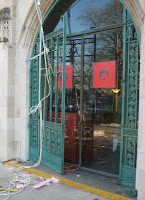 This is a bronze gate that we installed at a church on 5th Ave. in Manhattan. We did not do the refinish work on the gate itself. The gate was removed in the summer by an art foundry and taken to their shop where it was blasted to clean metal (white bronze) and then patinated to the green color.
This is a bronze gate that we installed at a church on 5th Ave. in Manhattan. We did not do the refinish work on the gate itself. The gate was removed in the summer by an art foundry and taken to their shop where it was blasted to clean metal (white bronze) and then patinated to the green color.Our role in the project has been focused on the metal-to-limestone anchor system -- the original manner of attachment some 70 years ago had caused damaged to the limestone and the gate was in danger to fall out of the opening of its own accord. Plus there had been various re-attachment campaigns over the years that helped to exacerbate the original muddles. This time around a modification was worked out for the attachment of the gate to the structure and it was our role to interface with the stone (anchoring), and to make repairs to the damaged stone surround of the opening. We also inherited the task of installing the gate back into the opening.
As with any project we discovered other unanticipated problems with the original design and installation. Compounding the logistics of the project is the coffee shop that went into business after the gates were removed.
But what fascinated me the most is the hinge system.












The leaves of the gate are heavy, roughly I would estimate at 600 lbs each. It took four of us to move them just enough to lift them a few inches and place them in the opening. We were seriously concerned that we might drop them. We were lucky in that we did not.
Each leaf of the gate has four hinges, for a total of eight.
The frame of the gate has a receiver that, though it cannot be seen in any of the photos, has a convex ball bottom that the hinge post, which has a concave ball bottom, fits to. The post threads down from the top into the hinge on the leaf side, and once it is in place a screw is inserted into it to provide a lock... so that the hinge post does not work itself out of the hinge when the leaves are swung. When that is all assembled then a top nut (what looks like a button with a screwdriver slot) is screwed in at the top of the hinge. In the end when all is assembled, and everything equally patinated it will not be glaringly obvious how the post hinges work.
In installing the gate the posts are screwed down to flush with the bottom of the holder on the leaf side, one of the posts lowered to fall into a receiver, and then once the gate is placed each post is screwed down into the receiver. The receiver itself is flanged (like a funnel) on the interior so as the post is screwed down it is guided into the receiver.
Once the posts are all in place the leaves of the gate move sweet as melted butter.
Playing with bronze doors and gates is not something that we do a whole lot of. The last time that we had a gig similar to this was at St. Bartholomew's Church (51st & Park) where the south bronze door was stuck shut and they needed to have it opened for the Xmas season (need for operable egress with an increased number of people inside of the church). Those doors weighed a considerable amount more than this bronze gate.
Wikipedia: "The magnificent bronze doors, with bas-reliefs in panels depicting episodes from the Old and New Testaments, had been carried out by some of New York's established sculptors: Andrew O'Connor, working freely under the general direction of Daniel Chester French, executed the main door; the south door was executed by Herbert Adams, the north door by Philip Martiny."


No comments:
Post a Comment